Since garlic at the market is usually pretty cheap and available year-round, it doesn’t occur to many people to grow their own. But garlic is a seasonal crop that tastes much better when it’s truly fresh – just harvested garlic is amazing. The big plump cloves have a strong garlic pungency but are also almost juicy.
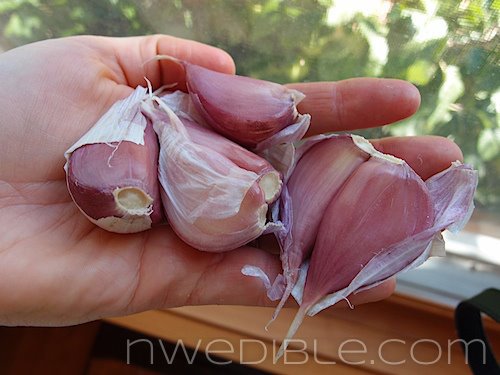
I’ve grown garlic every year for about a decade now, and, unless you are cursed with one of the various root rots or fungal diseases that seem overly fond of the allium family, garlic is very simple to grow.
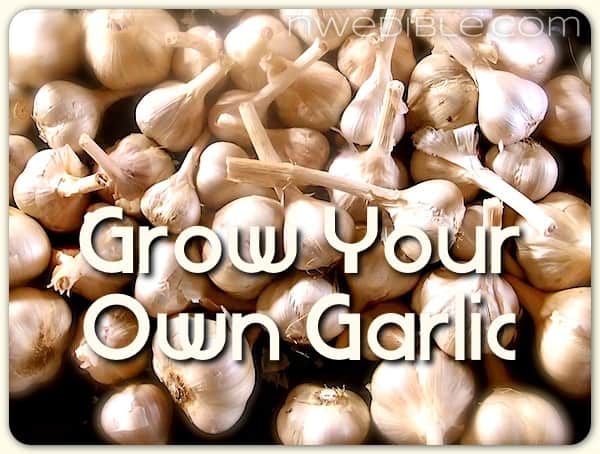
Seed Garlic
You start with seed garlic. This can be certified virus-free garlic you’ve ordered from a specialty supplier, or it can be garlic you’ve saved over from the summer harvest. I advise strongly against planting supermarket garlic, which, in addition to being a boring commercial variety, is almost certainly carrying some kind of virus which can contaminate your garden soil.
I would also politely decline offers from people who want to share their garlic or other alliums with you to plant in your garden. This is of course a personal call, but my soil “caught” allium white rot after I eagerly planted someone’s grandmother’s heritage heirloom old-country shallot variety that I picked up at a seed swap.
Before Typhoid Mary Shallots: growing garlic was as easy as falling off a log. After Typhoid Mary Shallots: I have to be very careful about what beds get alliums, and usually do a back-up container planting of garlic in fresh potting mix just to ensure some garlic harvest. It sucks.
If you buy your garlic, expect it to be sold by the half and full pound. Depending on the variety you buy, one pound of garlic will yield about four to seven heads of garlic. Your purchased garlic should be certified virus-free and clean, with no signs of soft spots or decay.
Sometimes garlic shippers have to break a head into pieces to get the right weight of garlic in the package, but in general the garlic heads should be intact until just before planting. Seed garlic is expensive – if you order online or from a seed catalog and the garlic you get isn’t good enough to plant out, call and get yourself a refund. I’ve had to do it when I received half a head of soft, semi-rotten garlic.
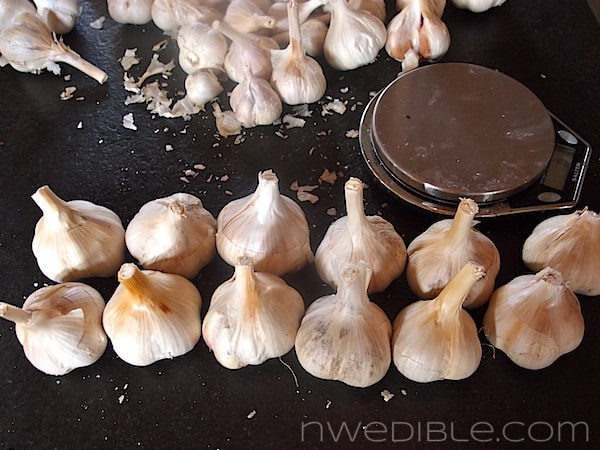
If you are planting your own garlic that you harvested the prior summer, make sure it shows no sign of disease and is firm and clean. Select the largest, healthiest looking heads to use as seed garlic – these will put out roots quickly and mature into large heads of garlic the following summer. Don’t bother planting small cloves – just eat them.
Hardneck vs Softneck Garlic
There are two categories of garlic – hardneck and softneck. I prefer hardneck because they are culinarily superior. I’m particularly partial to a large-cloved, high-yielding variety called Music, but there are advantages to both types.
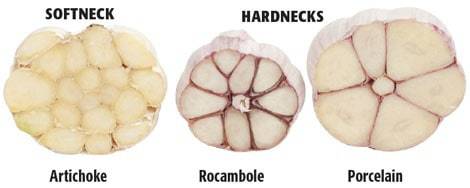
Hardneck Garlic – these types of garlics bolt, throwing up a central stalk called a scape in early summer. If allowed to grow, the scape will flower, taking energy from the bulb formation. This scape dries to a very hard “neck” that runs all the way down to the rootplate of the garlic bulb.
- Hardiest of the garlics and good for cold climate gardeners.
- Make “scapes” in early summer that are a secondary crop to harvest. Scapes should be removed for best bulb formation.
- Typically stronger, sharper and more diverse in flavor.
- Last 6-9 months in storage.
- Typically form a single ring of cloves, 4-12 to a head, that tend to be larger than softneck cloves.
- Hardnecks cannot be braided.
Softneck Garlic – The typical grocery store garlic is a softneck called California White. Softnecks do not bolt.
- Thrive in more mind climates and tolerate warmer winters – best for maritime and southern gardeners.
- Typically not sharp or spicy, but some softnecks are very full-flavored.
- Superior storage compared to hardneck types, lasting 9-12 months.
- Do not produce scapes, so softnecks can be braided nicely and require less labor to grow.
- Faster to mature than hardnecks.
- Typically make several rings of cloves, up to 40 cloves per head, many of which can be quite small.
Cracking Your Garlic
Just before planting, crack your heads of garlic into separate cloves. With hardnecks, this is easy. Just snap the dried scape back and forth a bit and the cloves should separate. With softneck garlic, you may have to peel the outer wrapper layers back more carefully before pushing the head against a countertop to break apart the cloves. 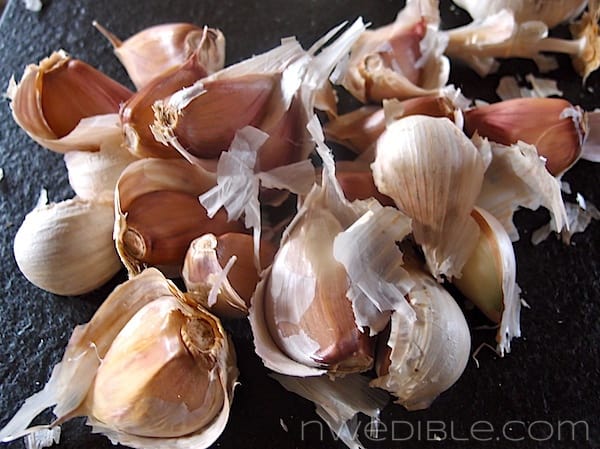
You want the individual cloves to fully separate from the rootplate and remain wrapped in their little paper coats. Sometimes the skin will fall right off a clove of garlic, as below. I’ve planted garlic like this and it’s worked out fine, but the papery skin will help prevent the clove from rotting in the ground, so this isn’t ideal.
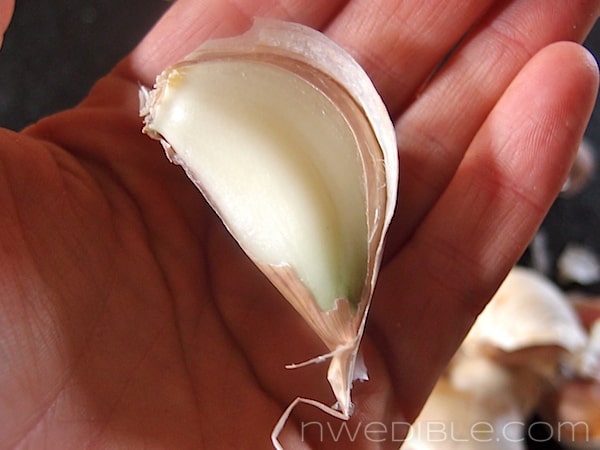
Prepare Your Soil
Garlic isn’t a particularly needy crop, but like just about everything it will grow best in full sun and fertile, well-drained soil with a goodly amount of organic matter.
I prepare a 4’x8′ bed by weeding, sprinkling the soil with Complete Organic Fertilizer and, if I’m feeling sassy, a little bit of bone meal. I rake the soil smooth and dibble in planting holes.
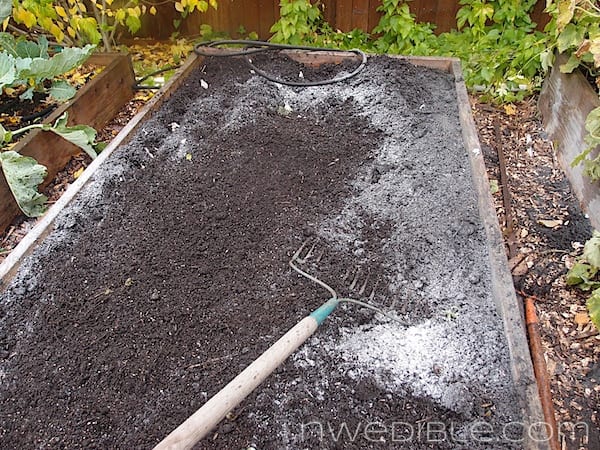
Get Those Cloves In The Ground!
Don’t wait around after you’ve cracked your garlic – get it planted within a few hours. Garlic can be planted in blocks, in long rows, or just stuck here and there throughout the landscape. I sow in blocks.
Block Spacing For Garlic
- 6-8″ apart in all directions
- 3-4″ deep to bottom of planting hole
- Firm soil over garlic cloves, water in if necessary (not necessary in the Pacific Northwest).
- Cover with 2-3″ of loose mulch
Place one clove, shoot end facing up, in each planting hole. (Ignore the first couple upside-down cloves in the photo below – my son helped me plant those.)
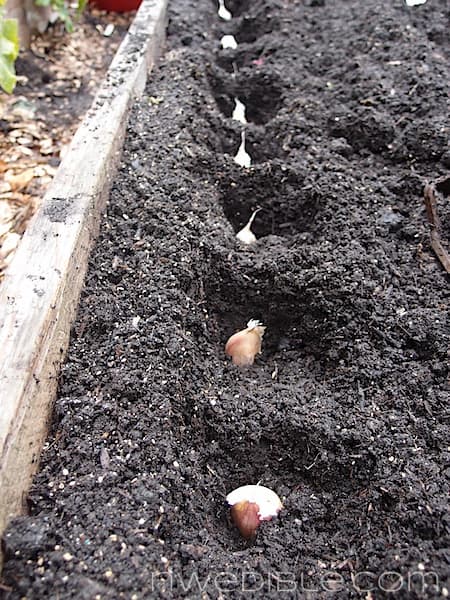
You want the garlic clove to go into the ground point up, just like this: 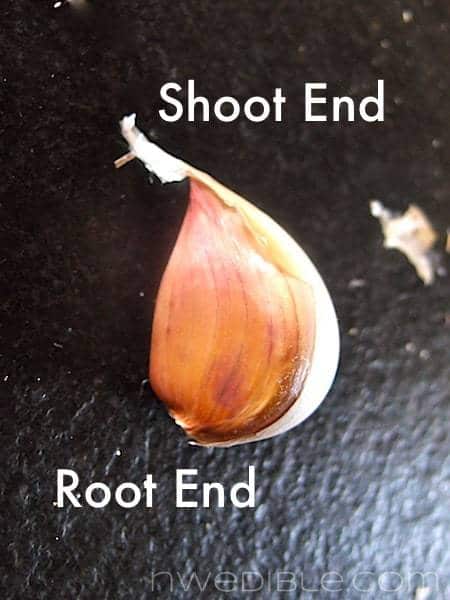
Another way to double check is to look for the root end is to look for the dry, flat spot on each clove called the basal plate. This is where the clove was attached to its garlic head. The basal plate goes down.
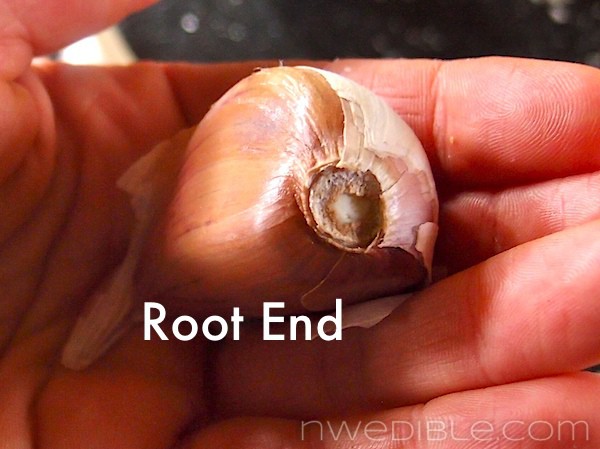
When Do I Plant? When Do I Harvest? (And Other Issues of Timing)
Perhaps the hardest part of growing garlic – just waiting for it to be ready.
In the Pacific Northwest, garlic should be planted in October. If you are reading this on the day I published it – October 14th – NOW would be a great time to go plant your garlic.
September is fine, but there’s always so much to do in September I can’t be bothered. By October things have slowed down. November is okay in a pinch, the earlier in the month the better. You want the clove to send out roots and establish itself in nice welcoming, moderate-temperature Fall soil, not sulk in the cold mud-puddle dirt of winter and possibly rot.
Garlic should send up little green shoots within several weeks of planting. By late winter they will be several inches tall. The plant will put on tons of strappy leafy green growth as spring rolls into summer and will reach several feet in height. Side dress with blood meal if necessary in spring or early summer to encourage rapid growth of the leaves.

If you have a hardneck variety, in about June, expect to see a tall scape unfurling up from the garlic. I usually wait until the scape are 8-12″ long and then snip them off. They are perfectly edible and taste kinda like a garlicy green bean.
In high summer, the garlic plant will begin to die down. This is totally normal. The leaves, starting with the oldest and bottom-most, will begin to turn yellow and dry out. This die-down is the garlic plant sending all the stored energy from the leaf mass down to the bulb underground, which is growing like crazy at this point.
When 4-6 green leaves remain on your garlic plant, it’s time to harvest your garlic! We’ll save harvesting and curing for another post.
The key takeaway for right now is, go get your garlic planted.
Is your garlic already in the ground? What kind of varietals do you grow?
I haven’t planted yet as I’m planning to buy a couple new varieties. I find that softnecks are much more productive for me here in the SF Bay Area. Hardnecks always seem to only sprout 50% of the time and produce small bulbs when they do sprout. The varieties we’ll be growing this year are California Early White, California Late White, Red Tochliavri, and Lahontan White. They also keep a lot longer than hardnecks and I like being able to braid them for storage. Hanging garlic helps with our limited space.
Thanks! We are new to the SF Bay area (from Denver). Good to know an opinion on what type grows best here.
I’ll plant my garlic either this week or next. I’ve been growing Music (hardneck) and Inchelium Red (Softneck) for YEARS. The only time I’ve had to buy garlic in the last twelve years was when my MIL came and took a dozen heads without asking.
WTH!!!!! You shoulda tackled her.
Good informative article. I had garlic rust for the first time in 40 years last year. Any tips prevention? The bulbs were fine to harvest, just a little smaller than usual. Apparently, rust is showing up in the Pacific N.W> more with our wet springs.
Have you considered hoops and a cloche in the rainy season when the rain is just too much? I’ve come to the conclusion that cloches aren’t for warmth, they are for DRY! lol
Great post! I just got my hardneck garlic in the mail last week and need to get it in the ground. I’ve been wanting to plant garlic for years but never got around to it, so I’m excited to finally get some planted this fall. Thanks for the tips and tutorial! 🙂
Great post, and happy Cascadian Thanksgiving to you and yours! I have grown my own garlic for decades. I grow hard neck AND braid it. It is entirely doable, just a bit harder. The award winning grower who used to supply me with porcelain (I love garl;ic but hate peeling, so the bigger the clove, the better) got the dreaded rot in one disastrous year. She lost 90% of her 3 acres of crop. I have struggled with it for years, in spite of scrupulous crop rotations. I refuse to quit. I now plant with the rot in mind: more than I will need, and place the cloves extra far apart. The rot has to spread from root to root. I have found perfectly healthy bulbs in the same row as disgustingly diseased ones. Until I heard Brian Minter on CBC, and today you, mentioning planting in containers that had simply never occurred to me! But now it will. Sunshine Mix #1 and COF in an old bathtub will hold my garlic next year, by way of crop insurance. Back in pre-rot days I used to plant thickly, and enjoy the thinnings as the earliest green. We call them garleeks, they are delicious.
I’ve planted Spanish Roja this year for harvesting the bulbs and Italian Late that I grew last year just for the greens. I got totally addicted to garlic greens last year. I’m considering trying a spring planting just to have greens during the dread period between harvest and new growth.
Do all types of garlic get the rot the same? Could mixing types work well? Or spreading them out between rows on non-allium? What is a good garlic plant partner?
Just a point of clarification here for newbies. You said: “one pound of garlic will yield about four to seven heads of garlic.” It might be better to say: one pound of seed garlic will contain about four to seven head of garlic. Once you separate those heads into individual cloves, each of which will grow into a head of garlic, the pound of seed garlic will yield anywhere from (fill in the blank) heads.
In my case I typically get about 7 plant-able cloves from each head. This of course depends on the variety. some do have beautiful huge cloves in the head, don’t they?!
Thanks as always!
OOOOOooohhh! THANK you! I was thinking, “so I’m going to spend something like $10 for maybe three heads of garlic?” 🙂
Thank you! Erica has such good readers that I figured the answer to my question about those numbers should be here somewhere.
Thanks a lot for this great post. My granny’s garlic always comes out small and has some moldy looking stuff on it. She keeps planting in the same plot so I will suggest her to move her garlic to a new plot.
I put mine in yesterday and today. Canadian Thanksgiving. I planted Music and Red Russian. I saw your picture of a Music in your hand and it is HUGE. I needed to have it. So I found some last year. It was small and a bit pitiful, but I ended up with some nice heads. So in they went!!! So happy to have you back Erica.
I grow Music, thanks to you! I am so happy about my seed for next year…getting them in the ground tomorrow. They were enormous, so I have high hopes for this next harvest. I must say, I would plant garlic just for the scapes. That’s why I plant 100% hardneck now. I love garlic, but garlic scape pesto pizza is one of my absolute favorite foods.
I have given up on garlic after it rotted three years in a row. I dont know if i have the dreaded virus (likely, since i planted grocery store garlic) or if its just too frigging wet here (also likely, as it is the wettest part of the wettest state in the union). Too bad, because i live garluc scapes! And garlic in general. Its hard to find good sharp hardneck varieties in the store. I like the super hot purple korean, and id love to be able to grow some.
Thank you! I’m a total newbie to garlic-growing. This helps a lot!!
This post was the encouragement I needed to go to our local garden shop and get Music seed garlic for the fresh, vacant lasagna garden in the backyard. I first added another layer of cured compost and, after planting several rows, I covered the area with ground-up dried leaves. I covered everything with a layer of vinyl-coated chicken wire and anchored it with tent pegs so a) the leaves will stay in place when the winter wind starts to blow and b) the chickens won’t dig in the fresh bed for garlic sprouts (which will make their eggs taste funky). Little did I know there would be another good reason for the layer of chicken wire. That same night a marauding family of skunks came through our yard and, under the light of a full moon, carried out a massive grub-hunting expedition. Don’t get me wrong – I’m grateful they went after the grubs and didn’t spend their unsupervised nocturnal time trying to jimmy open the hen house. But, I’m also pretty sure they would have also gone for fresh garlic if they’d had half a chance.
Garlic is one of those things I always mean to grow and never quite get around to. We eat a ton of garlic—and I’m addicted to garlic scape pesto, so I really ought to get to it.
So that’s why I didn’t get any scapes this year! Oops. But the random farmer’s market softneck was delicious.
Getting ready to plant garlic, this is my 4th year and I grow just about enough to keep me in garlic for a full year. It’s expensive and imported off season. I trade garlic with others and have managed to avoid any sort of rot or rust. I guess I’ve been warned! I have much better results with soft neck; last year I only grew St. Helen’s red and have a beautiful crop. This year I’m planting more St. Helen’s, along with Susanville, Oregon Blue and Inchelium Red. I rotate crops every year (in my tiny garden!) and I’ve been playing around with polycultures so I will probably plant these in various places. Whenever I plant alliums near my greesn, I see less slug damage.
and don’t forget to plant enough that you can pull some as green garlic in the spring – after they develop bulbs but before the cloves get very developed. Green garlic isn’t all that easy to find in the market(s), but is fun if you plant extra specifically to enjoy early.
If you only take a leaf or two off of each plant you can have both the green and the bulb for harvest. It doesn’t seem to bother the bulb production at all if you are restrained.
Thanks for the garlic info…always great to learn new things to improve our gardening. Till a year ago I’d been growing a purple Korean garlic given to me by a local (Korean) friend but then a family illness turned the world upside down a bit and I lost my seed crop. After reading about your success with Music it sounded like a good substitute so there is now an order of it waiting patiently to get in the ground soon. My friend said every year she and her husband put bone meal and blood meal in their garlic bed so I’ve been doing the same. We both live on the same side of town and most of our soil is pretty much just playground sand and always needs yearly compost and amendments.
Looking forward to the next installment of your garlic chronicle!
Molly
Another bonus of growing your own: Garlic greens. The greens are AMAZING. I just got back from living in South Korea, where garlic greens are a regular addition to many meals. They are flavourful and make a great garnish: A fabulous addition to any meat, in a salad, or as a substitute for green onion anywhere.
Hello! I am so excited to have found your site!! I am a newbie to gardening and very excited to start. Now… On to my question… Where does one suggest I find garlic seeds? I live in North central Arkansas.. Will I be able to start my garlic inside for the fall/winter? Sorry for all the questions:) and thank everyone for comments and time:)
I’ve been very pleased with the garlic I’ve ordered from Southern Exposure Seed Exchange. Their website has lots of cultural information as well!
I planted the hardneck variety this time last year. It grew and we were able to cut off and enjoy the scapes but then – it DISAPPEARED!!! I don’t know what happened but when we returned from a 2 week holiday and took a tour around the garden there it was – GONE! But a day or two ago I found little green shoots in a different part of the veg patch. Spooky!
Hi! What a fantastic site you have! I am interested in trying to grow garlic for the first time ever. I learned from you not to grow supermarket garlic. That alone will save me tremendous grief!
We LOVE garlic, especially whole cloves slightly browned and cooked until very soft in an inch of olive oil, then mixed with thin spaghetti and a good amount of freshly grated romano cheese – terrible for the blood sugar, but incredible for the soul two or three times per summer! When a recipe calls for a few cloves of garlic, we tend to read that as a few heads! Never too much garlic!
Lately, the only garlic my supermarket sells is really pure white garlic that doesn’t have much garlic taste or aroma at all, nor does it brown the way the other garlic they used to sell did when cooked immersed in olive oil. The garlic we used to love was also white, but you could see just a bit of purple through the skin and more upon peeling the outer layers. When you held the head to your nose, it had the most divine garlic aroma, and you could actually taste the garlic once it was cooked, not bland at all like the newer variety they sell now. From what I have learned from your site, I would say the type we liked was a softneck variety (never knew there was more than one type!). It was always harder to find, bit now we can not find it at all. We also have found that the elephant garlic they sell has beautiful huge cloves, but has even less scent and taste than the pure white garlic they now sell. The type we liked, if you ate enough of it with the pasta, you could actually smell it not just on your breathe, but on your skin hours later!
Do you have any idea what the older slightly purplish garlic might have been? Do you have any recommendations for what I should try to grow to most closely approximate the garlic we loved? We do not want anything with an unpleasantly sharp bite, but just a really wonderfully, there’s-no-mistaking-this-is-garlic, kind of scent and flavor!
Thank you so much!!
Hi Donna! It’s hard to know exactly what variety you loved, but I’d say Purple Glazer is a great bet to try. It’s a hard neck heirloom – been around forever – has lovely purple striping on the wrapper leaves and has a pure garlic flavor that’s particularly good when roasted or slow cooked in oil like you describe. I would say, when cooked, it’s sweet but but garlic, if you know what I mean. Try growing your own – it’s a very rewarding crop! Seed garlic is spendy initially, but save your best, largest heads from your own crop and replant those….this way the garlic becomes more and more adapted to your soil. Here’s Purple Glazer at High Mowing Seeds.
I found your website yesterday — Thanks for the tons of great info!
Good article. Just put in some Moroccan Creole Garlic. As well as an soft neck that I don’t know the name of, the seed company threw a bulb in for free. The soft neck has white paper with red skins on the cloves. The cloves are so large that their was only two per bulb. Anyone have any idea what variety it might be?
Thanks! This is just what I needed to know. Happily I bought three bulbs and one was music. Only problem- I accidentally mixed them up in the bag at the store before I thought of labeling them! I was shocked by the price, but was told they were special seed garlic. I thought that sounded really silly but now after reading your post, I know that I lucked out by finding seed garlic rather than just buying regular eating garlic which had been my original plan. Happily, I happened on the seed garlic at the Chimacum Farm stand.
Hi there,
I live in South Western Ontario, Canada and I planted garlic in June (soft necked ) and when I pulled one out in late Sept ,it looked like a green onion. Did I harvest it too soon? Help!!
Linda
It’s not that you harvested too soon so much as you didn’t plant early enough. This year, try planting in September/October and letting your garlic overwinter for a late summer harvest. I think you’ll have better results, even in a cold climate like Ontario.
Omg i just bought my garlic to plant in April so do I keep it until October?
Is it possible that my garlic is ready for harvest in mid May?? I suppose it’s been a very warm spring so far but im not sure if it’s yellowing so fast because its not doing well or I need to get it out of the ground. I already removed scapes just recently. I live in Seattle. It’s in a pot on a very sunny warm deck.
Can I plant garlic in any kind of soil?